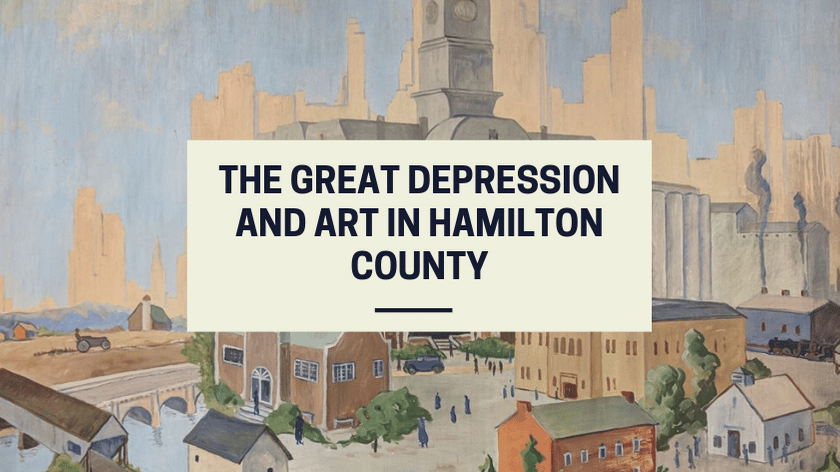By David Heighway, Hamilton County Historian
When Franklin D. Roosevelt took office in March 1933, his administration immediately created an overlapping “alphabet soup” of federal relief programs. It was recognized that artists needed to be supported as much as those in any other occupation, and so programs were created to employ artists to create public art that could be enjoyed by everyone. Some Hamilton County artists participated in these programs.
A rough outline of the structure of the programs is as follows: In 1933, the Federal Emergency Relief Administration (FERA) oversaw much direct relief and some rudimentary work programs. The short-lived Civil Works Administration (CWA) began late that year; it provided initial funding for the Public Works of Art Project (PWAP), which was run through the US Treasury. Local newspapers usually referred to projects as being funded by the CWA, but that was only temporary, ending in 1934. With the establishment of the Works Progress Administration in 1935, the Federal Art Project under the Works Progress Administration (WPA) was born. A separate program, the Treasury Relief Art Project (TRAP), started the same year and funded paintings and sculptures in new and existing federal buildings.
Among other activities, local artist Francis Clark Brown (sometimes referred to as Francois Brown) taught art classes in 1934 which were paid for by the CWA. However, these programs were known primarily for the creation of public artworks. There are six known federally-sponsored paintings connected with Hamilton County:
 “Yesterday, Today, and Tomorrow” – Francis Clark Brown (1908-1992), 1934, PWAP, presented to library, currently at Boys and Girls Club. [image – Keith Clock]
“Yesterday, Today, and Tomorrow” – Francis Clark Brown (1908-1992), 1934, PWAP, presented to library, currently at Boys and Girls Club. [image – Keith Clock]
This is an allegorical image of the growth of the city of Noblesville. In the foreground are pioneer buildings, some of which are recognizable. The courthouse is at center with more modern buildings around it. One structure is the Conner Street bridge over White River that was built in 1930. In the background are soaring skyscrapers for a fictional future of the city. The painting was meant to hang over the fireplace in the old library building on 10th Street.
“Rip Van Winkle” – Lee Offutt (1908-1966), 1934, PWAP, presented to library, whereabouts unknown.
This was painted specifically for the Children’s Room in the lower level of the library. A newspaper description said, “It shows the old Catskill house with figures gazing in astonishment as he returns after twenty years slumber.”
Untitled Courthouse mural – Francis Clark Brown, 1935, FERA, 6’ X 8’, whereabouts unknown.
This was originally hung on the second floor of the old courthouse. Like the library mural, this was meant to be allegorical. A newspaper description said, “It points out three departments of the government, executive, legislative, and judicial, and is not supposed to be realistic, but symbolic of a governor with the departments working hand in hand.”
“Mail, Transportation and Delivery” & “Early and Present-Day Indianapolis Life” – 1935, TRAP, Indianapolis Federal Building. [images – Library of Congress]
 “Waiting for the Mail” – 1938, TRAP, Nappanee Post Office.
“Waiting for the Mail” – 1938, TRAP, Nappanee Post Office.
Both by Grant Christian (1911-1989)
Christian was a nephew and protégé of Franklin Booth. He lived in Edinburg, Franklin County, but his family was from Noblesville. Christian Street on the south side of town is named for them. The Indianapolis mural was somewhat controversial because of the image of former Governor Paul V. McNutt by a beer keg. McNutt had been influential in repealing Prohibition. Both murals are featured among the works in the book, “A simple and vital design: the story of the Indiana post office murals” by John C Carlisle (Indiana Historical Society, 1995). Some sources claim that the Sheridan Post Office got a WPA mural. The building was built in 1940 using a New Deal design and murals were usually a part of that. However, no evidence has been found for one.
There was other Depression-era art connected to Hamilton County that was non-federally funded:
Libby, McNeil & Libby display, Chicago World’s Fair, Century of Progress Exposition – Ralph Applegate (1904-1978), 1933, whereabouts unknown.
Applegate was from Carmel and was another Booth protégé. He worked with Layman Whitney Associates on murals for the Exposition. At the time, a newspaper article said that he had created twenty canvases and a design for a steel decorative element. His largest work was for a display by the food company now known as Libby’s. It was a drawing etched onto glass panels and was large – thirty-two feet long by seven and a half feet high. A newspaper said, “Critics are unanimous in saying that in design and execution, it will be, without question, one of the major displays in commercial art at A Century of Progress exposition. … [It] has won the enthusiastic praise of critics of national importance.” Ironically, no photos can be found of it.
 Saturday Evening Post illustrations – George Brehm (1878-1966)
Saturday Evening Post illustrations – George Brehm (1878-1966)
I’ve mentioned George Brehm before. The Saturday Evening Post was Brehm’s primary employer during the 1930’s, and he did many illustrations for the magazine. One of his friends at the time was Thomas Hart Benton. Benton’s influence can be seen in Brehm’s illustrations for William Faulkner’s short story “The Bear Hunt” published in the Post on February 10, 1934. Most of the illustrations are still under copyright, but this unidentified image of a woman and young boy is from that time period. [HEPL collection]
Thanks to historian Glory-June Greiff for her expertise on New Deal arts programs and her assistance in writing about them.
